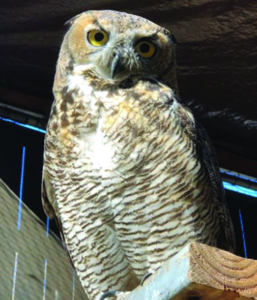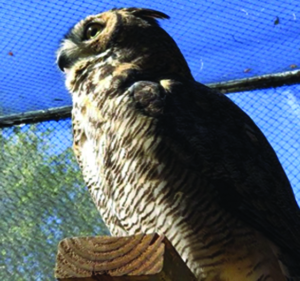A Great Horned Owl Flies Free
By Guthrum Purdin, DVM

Photo by Guthrum Purdin, DVM
This Great Horned Owl was brought to CWC from West Valley Animal Control one afternoon back in late September. There was no history to go with the transfer, why she had come into care was unknown. What was immediately apparent however, were abrasions on the bird’s cere (the base of the upper beak) and, although the talons could still grip, she was dehydrated and unable to stand. The wounds were cleaned and subcutaneous fluid given to rehydrate the bird.
In addition, nonsteroidal anti-inflammation medication was started. This was done to control possible pain, but even more importantly because head trauma was strongly suspected. A head injury, such as being hit by a car, can cause inflammation and swelling in the brain. Symptoms of brain swelling can take a few days to manifest, and that’s what we saw happening to this owl. Although able to stand on the second day in care, she was staring off into the distance as if unaware of what was going on around her, until she was actually touched by a caregiver. Her right wing was drooping with no injuries found by palpation or x-rays.
Then, two days later, she started spinning in circles. This worsened over the next few days. At any stimulus, the owl would start turning to the left, spinning repeatedly, over and over. Her pupils were very different sizes (called anisocoria), the left much larger than the right. The right eye would focus on moving objects, but the left would not, seemingly blind. Things were looking grim for the owl, and we feared she was not going to recover. When our veterinarian looked at her, he found the eyes were structurally normal, with no outward sign of injury; the problem seemed completely associated with her brain. Head trauma can cause “central blindness,” where the eyes are structurally normal, but there is damage to the visual centers of the brain. More promisingly, the owl would occasionally stop spinning and make the loud “beak clattering” noise that Great Horned Owls do to show aggression and as a warning to strangers to “back off!” Despite her cerebral compromise, she was self-aware enough to warn her caregivers to be wary. Now, when touched, she’d turn to bite. She always missed but was determined to try!
Treatment continued, and we monitored her carefully. If she could see people, she’d start spinning, but if left alone, would stop and relax. After about two weeks, the owl was eating on her own, no longer requiring being hand fed. Her eyes still had anisocoria, but less dramatically. When trying to bite, the owl now could snap down on what she aimed at—caregivers beware! The drooping wing had been wrapped until now, but that was no longer needed.
A few days later, the owl was moved to a shady, quiet, small aviary to allow more space and peace for recovery. The owl immediately went up to the low perches provided and settled in. Medication could be given in the food, and she was left in peace as much as possible. The owl still spun to the left when approached on the first day in the small aviary, but finally stopped for good by day two.

Photo by Guthrum Purdin, DVM
Improvement was gradual. Initially, flight was unusually noisy when taking off. This is a serious problem for owls. They rely on flying almost silently when hunting. Owls have specialized feathers that allow them to fly noiselessly. This enables them to descend on their prey without being detected. For this to work, the wings must be held at the proper angle. As this owl slowly regained normal use and positioning of her wings, flight became stronger and quieter. She initially would tire quickly after being moved to a large, flight training aviary. Staff and volunteers would go out and gently encourage flying, thus building up her strength and endurance.
It took weeks, but her pupils returned to normal. The owl was able to avoid objects placed in the aviary, fly silently, and land normally. But could she see well enough to hunt? During a “live prey test,” the owl swooped down, catching her dinner immediately after staff closed the aviary door. Feeding herself would be no problem; she was ready at last to return home! After nearly two months in care, this Great Horned Owl was returned to where she had originally been found.
When she first arrived, it really looked like the owl wouldn’t make it. Thanks to our dedicated staff and volunteers using their experience and attention to detail, this bird was given every opportunity to improve. Thanks also to the owl herself, for her fierceness and resilience. She’s out there somewhere right now, living wild and free.

I love reading this so much!! Such dedication was able to help this animal to health & freedom again. Thanks for all that you do!!
Wonderful news about the recovery of this owl, whose treatment clearly depended on deep knowledge of the species and the kind of behavior that is normal for it. The report mentions “nonsteroidal anti-inflammation medication.” Was that Meloxicam? I remember that during the past fall, an injured songbird, who was a CWC patient of the week, was reported as being given Meloxicam. This tickled me, because I had just been prescribed Meloxicam by a specialist, for a problem with pain in the lower back. I told her that the medicine is used by veterinarians, with reference to the CWC mailing, and she found that interesting.
Such heartwarming news! It just shows the love, professionalism and dedication of the staff and volunteers, who might have otherwise written the owl off. Well done!
Thank you! We couldn’t do it without supporters like you!
The number of medications that we use with the animals that are also used in people is astounding! It was indeed Meloxicam that the Owl benefitted from!
Thank you! We do our very best and have a great vet!
What a great story with a happy ending! Thank you for your dedication and persistence in helping this owl (and all manner of birds and animals). And thank you for taking the time to document, in such vivid detail, the treatment and healing process – it’s so educational and really brings to life the unique story of each animal and the important work you’re doing.